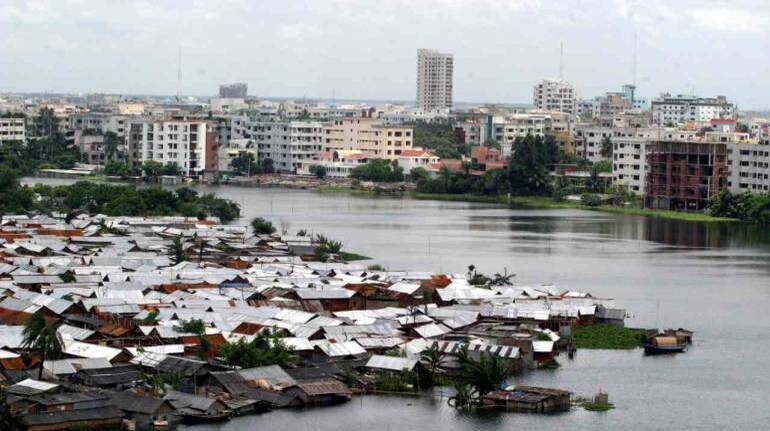

Subir Roy
India, now in the throes of an economic slowdown, does not need to look very far for a robust and healthily growing economy. Neighbouring Bangladesh has just put in 8.1 per cent growth (financial 2019), a rate that has been rising steadily since the 6.6 per cent achieved in 2015. This was powered by an industrial growth rate of 13 per cent, aided by exports growing at 10.1 per cent.
What is more, according to the outlook prepared by the Asian Development Bank, the current year is likely to see continued robust growth. This is despite the deteriorating global trade and growth environment. Macroeconomic stability will be maintained, inflation and the current account deficit being on an even keel. In view of this, the central bank monetary policy will continue to be accommodative.
In contrast, the latest monetary policy review of India’s central bank has lowered its growth forecast for the current year to 6.1 per cent from the 7.4 per cent forecast in the beginning of the year and cut the key policy rate by another 25 basis points to 5.15 per cent, down sharply from 8 per cent in January.
Bangladesh certainly needs the rapid growth as its per capital GDP (in purchasing power parity dollars) remains at just over half of India’s. However, what is significant is that despite low income levels, which put it firmly in the grip of income poverty, Bangladesh has over the years made some significant gains in terms of human development indicators.
This is illustrated by contrasting several key indicators for Bangladesh and India. Bangladesh is now ahead (all figures are the latest available and according the World Bank and Human Development Indicators) in life expectancy at birth at 72, compared to India at 69.1.
On the infant mortality rate (per thousand live births) Bangladesh scores better at 25.1, compared to India’s 31.5. It is in maternal mortality rate (per thousand live births) that India does significantly better at 170 compared to 210 for Bangladesh. The indicators for education are mixed. India does better in mean years of schooling at 6.4, compared to 5.8 for Bangladesh. However, Bangladesh is ahead in terms of women’s literacy, making a powerful comment on evolving social systems.
Thus, Bangladesh does quite well in terms of the level of well being (as measured by human development indicators) it has achieved for its people despite having a significantly lower level of income. If we go by the notion that income is not an end in itself but the means to a better quality of life, then Bangladesh has put its GDP to better use than India has.
Bangladesh’s current human development record can be attributed to the role played since its birth by aid and international development agencies, and most significantly its own robust NGOs such as Grameen Bank and BRAC (Building Resources Across Communities). Grameen Bank, founded by Nobel laurate Muhammad Yunus, has become an international role model in the field of microfinance.
In the 10 years of rule by the Awami League under the leadership of Sheikh Hasina, Bangladesh has adopted macroeconomic policies which have built upon the foundation laid by the aid agencies and NGO combine to achieve the current high GDP growth rate.
The essence of these policies is best outlined in Hasina’s own words. In an article penned in connection with her just-concluded India visit, she says: “Today, Bangladesh offers the most liberal investment regime in South Asia — in terms of legal protection of foreign investment, generous fiscal incentives, concession on machinery imports, unrestricted exit policy, full repatriation of dividend and capital on exit, for example. We are establishing 100 Special Economic Zones with one-stop service across Bangladesh. Twelve of the zones are already functioning.”
Thus, the high industrial growth achieved by Bangladesh can be attributed to an openness to foreign investment and improving the ease of doing business. This is in contrast to the policy situation prevailing in India today marked by a degree of protection and regulatory hurdles.
It is not as if the Bangladesh economy is robust across the board. The country’s success in garments has been widely cited but these account for 84 per cent of exports, highlighting the vulnerability resulting form relying on a single export commodity. Also, these exports are undertaken on extremely thin margins and workers have to live with very poor trade union rights and low incomes.
The political scene in Bangladesh has also evolved in a negative direction, with Hasina and her ruling Awami League running a virtual single-party dictatorship and democratic rights threatened by the strong armed actions of paramilitary forces. Plus the prime minister has herself highlighted the prevalence of corruption, cornering of favors by the politically well connected and great income inequality.
The big question that emerges is: if the Bangladesh economy is growing fast and the country is doing well in terms of human development indicators, then why are people continuing to migrate into India, as is popularly believed? Or are they? The reality is that the number of Bangladeshis in India has actually fallen between the 2001 and 2011 censuses, according to Chinmay Tumbe, of IIM Ahmedabad and author of India Moving: A History of Migration. The number of Bangladeshis in India, based on place of birth, fell from 3.7 million in 2001 to 2.7 million in 2011. This happened mostly in West Bengal, Assam and Tripura, which have a large concentration of Bangladeshi migrants.
The National Register of Citizens is supposed to capture the extent of undocumented immigrants but they were present during both the 2001 and 2011 censuses. So the fall has little to do with undocumented or illegal migrants. Also, potential Bangladeshi migrants are increasingly looking at Europe and the Persian Gulf as a first choice and so this is having an impact on their flow into India. This, as also the improving living conditions in Bangladesh may be contributing to a fall in the number of people of Bangladeshi origin in India and render the whole fear over illegal migrants leading to the NRC and citizenship bill unfounded in facts.
Subir Roy is a senior journalist and author. The views expressed are personal.
Discover the latest business news, Sensex, and Nifty updates. Obtain Personal Finance insights, tax queries, and expert opinions on Moneycontrol or download the Moneycontrol App to stay updated!